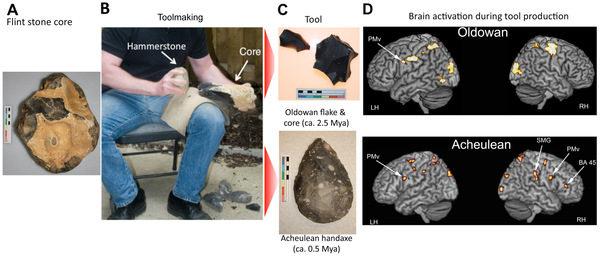Researchers have had different theories about why it took early humans more than 2 million years to develop stone axes. Some have suggested that early humans may have had underdeveloped motor skills or abilities, while others have suggested that it took human brains this time to develop more complex thoughts, in order to dream up better tool designs or think about better manufacturing techniques.
Stone Age humans were only able to develop relatively advanced tools after their brains evolved a greater capacity for complex thought, say researchers who used computer modeling and tiny sensors embedded in gloves to assess the complex hand skills that early humans needed in order to make two types of tools during the Lower Palaeolithic period, which began around 2.5 million years ago. The work involved a 'flintnapper' to faithfully replicate ancient tool-making techniques.
They say that comparing the manufacturing techniques used for both Stone Age tools provides evidence of how the human brain and human behavior evolved during the Lower Palaeolithic period.

Lower Palaeolithic toolmaking. A stone ‘core’ (A) is struck with a hammerstone (B) in order to detach sharp stone ‘flakes’. In Oldowan toolmaking (C, top) the detached flakes (left in photo) are used as simple cutting tools and the core (right in photo) is waste. In Acheulean toolmaking (C, bottom), strategic flake detachments are used to shape the core into a desired form, such as a handaxe. Both forms of toolmaking are associated with activation of left ventral premotor cortex (PMv), Acheulean toolmaking activates additional regions in the right hemisphere, including the supramarginal gyrus (SMG) of the inferior parietal lobule, right PMv, and the right hemisphere homolog of anterior Broca's area: Brodmann area 45 (BA 45) (Imaging data adapted from [6]). Credit: see citation below
Neuroscientist Dr Aldo Faisal, the lead author of the study from the Departments of Bioengineering and Computing at Imperial College London, says, "The advance from crude stone tools to elegant hand-held axes was a massive technological leap for our early human ancestors. Hand-held axes were a more useful tool for defence, hunting and routine work. Interestingly, our study reinforces the idea that tool making and language evolved together as both required more complex thought, making the end of the Lower Palaeolithic a pivotal time in our history. After this period, early humans left Africa and began to colonise other parts of the world."
The researchers behind the new study say their evidence, from studying both tool-making techniques, confirms that the evolution of the early human brain was behind the development of the hand-held axe. Furthermore, the team suggest that the advancement of hand-held axe production may have also coincided with the development of language, as these functions overlap in the same regions of the modern and early human brains.
The flintnapper who participated in the study created two types tools including the razor-sharp flakes and hand-held axes. He wore a data glove with sensors enmeshed into its fabric to record hand and arm movements during the production of these tools.
Dr Bruce Bradley, an expert flintnapper from the Department of Archaeology at Exeter University, creates a hand-held axe as part of the team's research.
After analyzing this data, the researchers discovered that both flake and hand-held axe manufacturing techniques were equally complex, requiring the same kind of hand and arm dexterity. This enabled the scientists to rule out motor skills as the principal factor for holding up stone tool development.
The team deduced from their results that the axe tool required a high level of brain processing in overlapping areas of the brain that are responsible for a range of different functions including vocal cords and complex hand gestures.
In the future, the team plan to use their technology to compare tools made by Neanderthals, an extinct ancestor of humans, to glean insights into their brain development.
Citation: Faisal A, Stout D, Apel J, Bradley B (2010) The Manipulative Complexity of Lower Paleolithic Stone Toolmaking. PLoS ONE 5(11): e13718. doi:10.1371/journal.pone.0013718






Comments